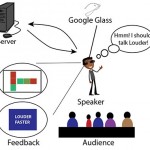 There isn’t much in life that’s more nerve wracking than speaking in front of a large audience. Researchers from the University of Rochester believe they’ve come up with something that may be able to help.
There isn’t much in life that’s more nerve wracking than speaking in front of a large audience. Researchers from the University of Rochester believe they’ve come up with something that may be able to help.
They have developed an application for smart glasses that will give you a range of feedback on your performance in real time.
The service, called Rhema, which is freely available via the team’s website, was presented at a recent conference in Atlanta.
The service will provide speakers with a recording of their speech, with their presentation analyzed in real time for things such as volume and speech rate. This data is then presented to the speaker live to hopefully allow them to adjust either their cadence or volume (or ignore the advice altogether).
The authors have analyzed, and indeed tested out, the glasses themselves whilst giving lectures over the last year.
“My wife always tells me that I end up speaking too softly,” they say. “Rhema reminded me to keep my volume up. It was a good experience.”
The hope is that by being more aware of these things, and getting objective feedback, it will aid our presentations even when not wearing the glasses.
Providing real time feedback
Of course, the provision of real-time feedback presents a number of challenges.
“One challenge is to keep the speakers informed about their speaking performance without distracting them from their speech,” they reveal. “A significant enough distraction can introduce unnatural behaviors, such as stuttering or awkward pausing. Secondly, the head mounted display is positioned near the eye, which might cause inadvertent attention shifts.”
In a bid to overcome this, they thoroughly tested the glasses on a group of speakers, testing out a range of feedback mechanisms as they went. For instance, they tried out using a traffic light like system of lights, using written feedback, data in graph form, and even more unusual methods such as providing a continuous and slowly changing display, or providing sparse feedback once or twice during a talk.
After testing, it emerged that the most effective form was to provide a written prompt every 20 seconds or so. So the speaker might receive a prompt to speak louder, or slow their cadence down, or even nothing at all if they’re already on track.
In addition to testing the system on speakers themselves, they also wanted to gain some feedback from the audience too.
“We wanted to check if the speaker looking at the feedback appearing on the glasses would be distracting to the audience,” they say. “We also wanted the audience to rate if the person appeared spontaneous, paused too much, used too many filler words and maintained good eye contact under the three conditions: word feedback, continuous feedback, and no feedback.”
Interestingly, it emerged that there wasn’t really any difference at all, whether on things such as eye contact, being distracted, unnatural use of words or appearing stiff on stage.
To further test the system, the researchers want to work closely with Toastmasters International to put it through a rigorous examination from people steeped in public speaking.
If you do a lot of public speaking, some invaluable help could be on its way to you very soon.
Check out Rhema in action via the video below.
Miliband was awful last night with his longing stares into the camera. To think he was trained to do that.
This would be really useful for improving our presentation skills.
Fascinating concept. It's hard not to think it would be distracting, but it sounds like they've taken that into account so who knows.
At first glance, I thought this was going to have eye sensors that told you if you were looking up, down or not addressing the entire room. Maybe that's phase 2? haha, this is a very cool concept though.
Well it's a system that can be modified so I'm sure it will be added to over time to include all manner of other features. It'll be fascinating to see how it (and other similar technologies) evolve over time.
Yeah, I could see how this could become a useful tool for speaking to various audiences, specially over a long period, i.e. 90 minutes or 1/2 day session. Challenge is indeed to see how this technology won't distract the speaker, cutting his or her train of thoughts for example. But with practice, it can certainly become quite handy…
Let's see how this technology evolves!
FG
I know you do a lot of speaking yourself Frederic. Would you consider trying something like this out?
Looks useful, although I suspect for a truly nervous speaker, this could be distracting or even dent confidence whilst mid-flow. In principle, though, I like it and I'm sure it could be the beginning of something more sophisticated that looks way beyond just volume and speed.
Yes, I think we're probably quite similar in that the concept of public speaking scares the crap out of us 🙂 Useful for pros like Frederic though perhaps 🙂
Haha, what a fascinating concept. I'm sure it would take a bit of getting used to, but once you did it could provide some incredibly rich and impartial feedback on your performance. I could see this sort of thing really taking off.